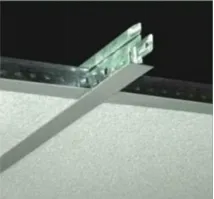- Afrikaans
- Albanian
- Amharic
- Arabic
- Armenian
- Azerbaijani
- Basque
- Belarusian
- Bengali
- Bosnian
- Bulgarian
- Catalan
- Cebuano
- Corsican
- Croatian
- Czech
- Danish
- Dutch
- English
- Esperanto
- Estonian
- French
- German
- Greek
- Hindi
- Indonesian
- irish
- Italian
- Japanese
- Korean
- Lao
- Malay
- Myanmar
- Norwegian
- Norwegian
- Polish
- Portuguese
- Romanian
- Russian
- Serbian
- Spanish
- Swedish
- Thai
- Turkish
- Ukrainian
- Uzbek
- Vietnamese
stu . 18, 2024 14:32 Back to list
grid ceiling tiles material
Understanding Grid Ceiling Tiles Material A Comprehensive Guide
Grid ceiling tiles have become an integral component of modern architectural design and construction. These tiles, also known as drop ceiling tiles or suspended ceiling tiles, offer a practical solution for improving the aesthetics and functionality of interior spaces. This article explores the various materials used in grid ceiling tiles, their benefits, and considerations for choosing the right material for your needs.
What are Grid Ceiling Tiles?
Grid ceiling tiles are designed to fit into a suspended ceiling framework, which consists of a metal grid system. This system allows the tiles to be easily installed, removed, and replaced. They are commonly used in commercial spaces, such as offices, schools, hospitals, and retail stores, but are increasingly finding their way into residential applications as well.
Common Materials Used in Grid Ceiling Tiles
1. Mineral Fiber
Mineral fiber tiles are among the most popular options for grid ceilings. Made from a combination of natural and synthetic fibers, these tiles are lightweight, easy to install, and provide excellent sound absorption properties. They often come with a textured finish and are available in various styles, making them suitable for various design aesthetics. Mineral fiber tiles are also resistant to mold and mildew, which is essential in maintaining a healthy indoor environment.
2. Fiberglass
Fiberglass ceiling tiles are another widely used option, known for their superior acoustic performance and thermal insulation properties. These tiles are constructed from glass fibers and are often coated with a protective layer to enhance durability. Fiberglass tiles are lightweight and easy to manipulate, making them practical for large-scale projects. Moreover, they are moisture-resistant, which helps in environments prone to humidity, such as kitchens and bathrooms.
PVC ceiling tiles are gaining popularity due to their versatility and ease of maintenance. These tiles are waterproof, making them an excellent choice for areas subject to spills and humidity. PVC tiles are available in a variety of colors and patterns, allowing for creative design possibilities. They are also lightweight and can be easily cut to fit any grid system, making installation straightforward.
4. Metal
Metal ceiling tiles, often made from aluminum or galvanized steel, offer a sleek and modern look. These tiles are highly durable and can withstand a variety of environmental conditions, making them suitable for industrial and commercial applications. Metal ceiling tiles also reflect light well, which can enhance the brightness of a space. However, they may require additional noise control measures, as metal surfaces can amplify sound.
grid ceiling tiles material

5. Wood
For a more natural and warm aesthetic, wood ceiling tiles are an excellent choice. While they may be heavier than other materials, wooden tiles can add a unique character to any space. They are also effective at absorbing sound and can be treated for fire resistance. However, wood tiles require more maintenance than other materials and may not be suitable for high-moisture areas.
Benefits of Grid Ceiling Tiles
Grid ceiling tiles offer numerous advantages that contribute to their widespread use. First, they provide easy access to plumbing, electrical, and HVAC systems concealed above the ceiling, facilitating maintenance and repairs. Second, they can help improve indoor acoustics by reducing noise levels, particularly in large or open spaces. Third, these tiles can contribute to thermal insulation, helping to regulate temperatures and reduce energy costs.
Considerations When Choosing Ceiling Tile Material
When selecting the right grid ceiling tile material, consider the following factors
- Functionality Assess the specific needs of the space. For example, areas with high moisture levels may require moisture-resistant tiles, while sound-dampening properties may be a priority for conference rooms.
- Aesthetics Choose a material and design that aligns with the overall interior design of the space. The color, texture, and style of the tiles can significantly impact the room’s ambiance.
- Budget Different materials come at varying price points. Balance the initial cost with long-term benefits such as durability and maintenance requirements.
- Installation Some materials may require professional installation, while others can be easily handled as a DIY project. Consider your skills and resources when making a choice.
Conclusion
Grid ceiling tiles are a versatile and functional choice for both commercial and residential spaces. By understanding the different materials available and their respective benefits, you can make an informed decision that meets your aesthetic and practical needs. Whether you opt for mineral fiber, fiberglass, PVC, metal, or wood, grid ceiling tiles can enhance the look and functionality of any room with minimal effort.
-
Transform Interiors with PVC Gypsum Ceiling: A Stylish, Durable, and Moisture-Resistant SolutionNewsMay.19,2025
-
The Smart Interior Upgrade: Discover the Durability and Versatility of Gypsum Ceiling Access Panel SolutionsNewsMay.19,2025
-
The Smart Choice for Interior Design: Discover the Value of PVC Gypsum Ceiling SolutionsNewsMay.19,2025
-
Mineral Fiber Ceiling Tiles: The Smart Blend of Performance and AestheticsNewsMay.19,2025
-
Mineral Fiber Ceiling Tiles: The Superior Choice Over Gypsum for Sound and Fire SafetyNewsMay.19,2025
-
Mineral Fiber Ceiling Tiles: Eco-Friendly Strength and Style for Every CeilingNewsMay.19,2025







